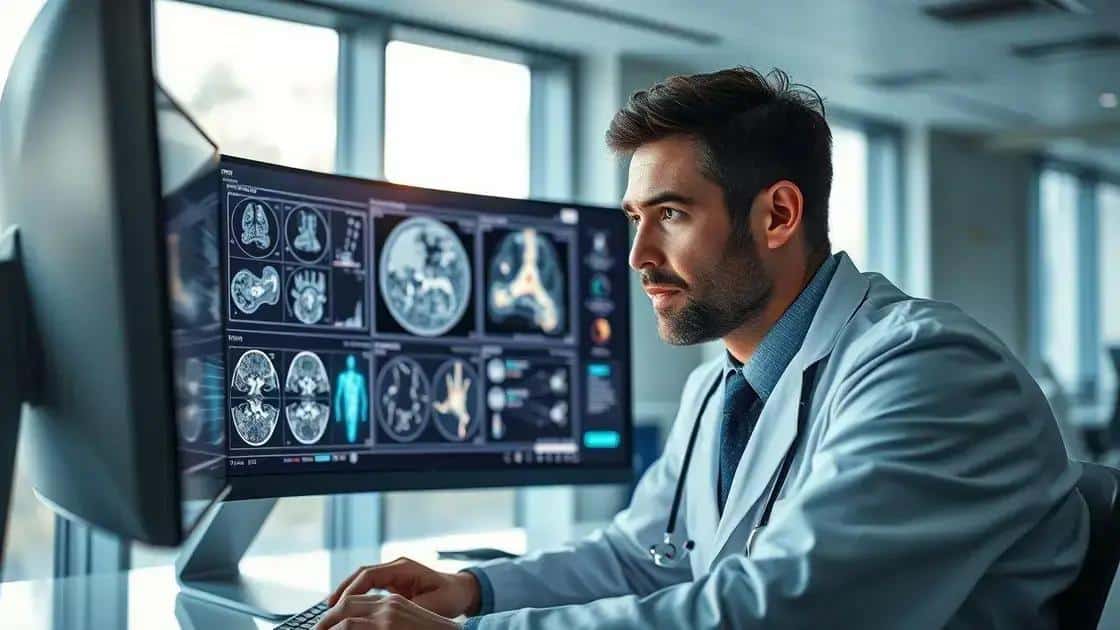New healthcare innovations improving patient care

New healthcare innovations, including telemedicine, AI diagnostics, wearable technology, and personalized medicine, enhance patient care by providing faster, more accurate treatments and empowering individuals to manage their health effectively.
New healthcare innovations are changing the landscape of how we receive medical care. Have you ever wondered how technology can enhance your health experience? Let’s dive into these exciting advancements that promise to make health management more effective and personal.
Telemedicine: Accessibility and convenience
Telemedicine is revolutionizing healthcare by providing accessibility and convenience to patients everywhere. Imagine having the ability to consult a doctor from the comfort of your home. This technology bridges the gap between patients and healthcare providers, making it easier to receive care.
Benefits of Telemedicine
The benefits of telemedicine are numerous and impactful. Patients can schedule appointments quickly and easily. They can also avoid long waits and travel to clinics. This is especially important for those living in rural areas.
- Reduced travel time and costs
- Immediate access to specialists
- Improved management of chronic conditions
- Flexibility in appointment scheduling
Moreover, telemedicine offers a private and secure way for individuals to discuss their health concerns without feeling anxious. This creates a safe environment where patients can feel more at ease during consultations. The technology is also designed to be user-friendly, allowing patients of all ages to connect easily.
How Telemedicine Works
Patients typically use a smartphone or computer to connect with their healthcare provider. Through video calls or chats, they can share symptoms, ask questions, and receive diagnoses. This interaction is often just as effective as an in-person visit.
The flexibility of telemedicine makes it a great option for busy individuals. With a few clicks, patients can get the care they need without disrupting their daily routines. Additionally, many insurance providers now cover telemedicine services, making it a viable option for more people.
AI in diagnostics: Faster and more accurate

AI in diagnostics is changing the way we approach healthcare. With technology improving daily, patients can benefit from faster and more accurate diagnoses. This innovation is particularly vital in identifying diseases early, which can lead to better treatment outcomes.
The Role of AI in Diagnostics
AI systems analyze medical data, such as images and test results. They identify patterns that might not be visible to the human eye. By doing so, they assist healthcare professionals in making informed decisions. This collaboration between AI and doctors enhances the overall accuracy of diagnoses.
- Enhanced image analysis for radiology
- Predictive analytics for early disease detection
- Natural language processing for better patient records
- AID in genetic testing interpretation
Moreover, AI can sift through vast amounts of data quickly, making it possible to study trends across patient populations. This speed is crucial for developing effective treatment plans. If a clinician suspects a condition, AI tools can provide a second opinion almost instantly, thus reducing the waiting time for patients.
Benefits of AI-Driven Diagnostics
Patients experience numerous benefits from AI-driven diagnostics. These include reduced time to diagnosis and less invasive testing methods. For instance, patterns indicating potential issues can be flagged before a patient even feels symptoms, allowing for proactive care.
As healthcare shifts toward data-driven approaches, the integration of AI in diagnostics will likely continue to expand. This will provide patients and doctors with powerful tools to navigate complex health scenarios.
Wearable technology: Monitoring health in real-time
Wearable technology is transforming healthcare by enabling real-time monitoring of health conditions. With devices like smartwatches and fitness trackers, individuals can easily track their vital signs and physical activity throughout the day.
How Wearable Technology Works
These devices often include sensors that collect data about heart rate, steps taken, and even sleep quality. By syncing this information with a smartphone app or a computer, users gain insights into their health trends. This continuous data flow allows users to manage their health proactively.
- Heart rate monitoring for fitness and alertness
- Sleep tracking to improve rest quality
- Step counting for better activity levels
- Calorie tracking for nutritional awareness
Many wearables also support notifications for reminders about medication or to encourage movement throughout the day. This level of engagement encourages healthier habits and can lead to improved overall well-being. The convenience of having health data at one’s fingertips is invaluable for individuals wanting to maintain an active lifestyle.
The Impact of Wearable Health Devices
Wearable technology also plays a vital role in chronic disease management. Patients with conditions like diabetes can use these devices to track their blood sugar levels. The real-time feedback they provide can lead to better decision-making regarding diet and medication.
In addition, the collected data may help healthcare providers better understand a patient’s condition, leading to personalized treatment plans. The ability to monitor health continuously creates opportunities to catch potential issues before they become serious problems.
Personalized medicine: Tailoring treatments for individuals

Personalized medicine is at the forefront of modern healthcare, focusing on tailoring treatments to individual patients. This approach recognizes that each person is unique, and their medical care should reflect that uniqueness.
What is Personalized Medicine?
Personalized medicine uses information about a patient’s genes, environment, and lifestyle to create customized treatment plans. Instead of using a one-size-fits-all model, doctors can base their decisions on specific factors that influence a patient’s health. This leads to more effective and efficient healthcare.
- Targeted therapies for specific genetic markers
- Medications tailored to metabolic responses
- Preventative measures based on family history
- Customized health plans considering personal lifestyle
The use of genetic testing has significantly advanced personalized medicine. By understanding a patients’ genetics, healthcare providers can discover how a person may respond to certain medications. This can prevent adverse effects and increase treatment efficacy.
The Benefits of Tailored Treatments
With personalized medicine, patients often experience better outcomes. They are more likely to respond well to treatments that are specifically designed for their genetic makeup. Additionally, this approach can reduce the number of trial-and-error prescriptions, making the process smoother and less time-consuming.
Furthermore, personalized medicine fosters a more collaborative relationship between patients and healthcare providers. Patients feel more engaged in their care decisions, leading to higher satisfaction. As this field continues to evolve, the hope is that more treatments will become available, enhancing the quality of care for everyone.
FAQ – Frequently Asked Questions about New Healthcare Innovations
What is telemedicine and how does it benefit patients?
Telemedicine allows patients to consult with healthcare providers from home, improving access to care and reducing travel time.
How does wearable technology monitor health?
Wearable technology tracks metrics like heart rate and activity levels in real-time, helping users stay informed about their health.
What role does AI play in diagnostics?
AI enhances diagnostics by analyzing data quickly and accurately, enabling faster identification of health issues.
What does personalized medicine involve?
Personalized medicine tailors treatment plans based on individual genetics, lifestyle, and health information, enhancing treatment effectiveness.






